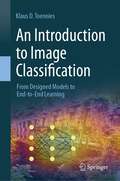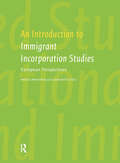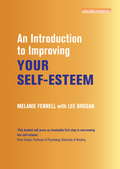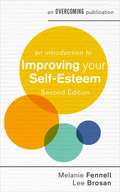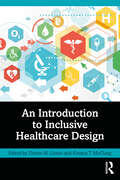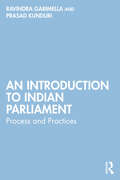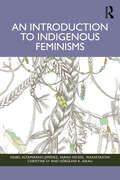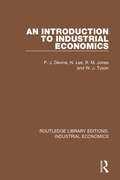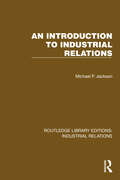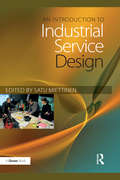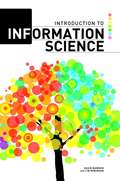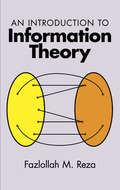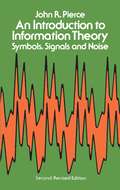- Table View
- List View
An Introduction to Image Classification: From Designed Models to End-to-End Learning
by Klaus D. ToenniesImage classification is a critical component in computer vision tasks and has numerous applications. Traditional methods for image classification involve feature extraction and classification in feature space. Current state-of-the-art methods utilize end-to-end learning with deep neural networks, where feature extraction and classification are integrated into the model. Understanding traditional image classification is important because many of its design concepts directly correspond to components of a neural network. This knowledge can help demystify the behavior of these networks, which may seem opaque at first sight. The book starts from introducing methods for model-driven feature extraction and classification, including basic computer vision techniques for extracting high-level semantics from images. A brief overview of probabilistic classification with generative and discriminative classifiers is then provided. Next, neural networks are presented as a means to learn a classification model directly from labeled sample images, with individual components of the network discussed. The relationships between network components and those of a traditional designed model are explored, and different concepts for regularizing model training are explained. Finally, various methods for analyzing what a network has learned are covered in the closing section of the book. The topic of image classification is presented as a thoroughly curated sequence of steps that gradually increase understanding of the working of a fully trainable classifier. Practical exercises in Python/Keras/Tensorflow have been designed to allow for experimental exploration of these concepts. In each chapter, suitable functions from Python modules are briefly introduced to provide students with the necessary tools to conduct these experiments.
An Introduction to Immigrant Incorporation Studies: European Perspectives (IMISCOE Textbooks)
by Jan Rath Marco MartinielloFocusing mainly on the European experience including Eastern Europe, this important volume offers an advanced introduction to immigrant incorporation studies from a historical, empirical and theoretical perspective. Beyond incorporation theories, renowned scholars in the field explore incorporation in action in different fields, policy issues and normative dimensions.
An Introduction to Implicit Bias: Knowledge, Justice, and the Social Mind
by Erin Beeghly Alex MadvaWritten by a diverse range of scholars, this accessible introductory volume asks: What is implicit bias? How does implicit bias compromise our knowledge of others and social reality? How does implicit bias affect us, as individuals and participants in larger social and political institutions, and what can we do to combat biases? An interdisciplinary enterprise, the volume brings together the philosophical perspective of the humanities with the perspective of the social sciences to develop rich lines of inquiry. Its twelve chapters are written in a non-technical style, using relatable examples that help readers understand what implicit bias is, its significance, and the controversies surrounding it. Each chapter includes discussion questions and additional annotated reading suggestions, and a companion webpage contains teaching resources. The volume is an invaluable resource for students—and researchers—seeking to understand criticisms surrounding implicit bias, as well as how one might answer them by adopting a more nuanced understanding of bias and its role in maintaining social injustice.
An Introduction to Improving Your Self-Esteem
by Leonora Brosan Dr Melanie FennellA new addition to the popular Introduction to Coping with series of CBT-based self-help booklets. Written by the author of the bestselling Overcoming Low Self-Esteem and the popular self-help title Overcoming Stress, An Introduction to Coping with Low Self-Esteem offers expert advice to anyone struggling with self-confidence. Includes helpful information on what causes and maintains low self-esteem and proven CBT strategies to beat it.
An Introduction to Improving Your Self-Esteem, 2nd Edition
by Melanie Fennell Leonora BrosanLow self-esteem can impact on many areas of your life such as your relationships, work life and general wellbeing. This invaluable self-help guide will help you to understand what has led to your poor self-esteem, what keeps it going and how to improve your self-image, gaining a more balanced and positive view of yourself. This self-help guide is based on clinically proven cognitive behavioural therapy (CBT) techniques to help you improve your confidence. You will learn:- How low self-esteem develops- How to challenge negative predictions- How to improve self-acceptance
An Introduction to Improving Your Self-Esteem, 2nd Edition (An Introduction to Coping series)
by Leonora Brosan Dr Melanie FennellLow self-esteem can impact on many areas of your life such as your relationships, work life and general wellbeing. This invaluable self-help guide will help you to understand what has led to your poor self-esteem, what keeps it going and how to improve your self-image, gaining a more balanced and positive view of yourself. This self-help guide is based on clinically proven cognitive behavioural therapy (CBT) techniques to help you improve your confidence. You will learn:- How low self-esteem develops- How to challenge negative predictions- How to improve self-acceptance
An Introduction to Improving Your Self-Esteem, 2nd Edition (Overcoming Ser.)
by Melanie Fennell Leonora BrosanOvercoming app now available.This is a new addition to the popular Introduction to Coping with series of CBT-based self-help booklets. Written by the author of the bestselling Overcoming Low Self-Esteem and the popular self-help title Overcoming Stress, An Introduction to Coping with Low Self-Esteem offers expert advice to anyone struggling with self-confidence. Includes helpful information on what causes and maintains low self-esteem and proven CBT strategies to beat it.
An Introduction to Inclusive Healthcare Design
by Denise M. Linton Kiwana T. McClungAn Introduction to Inclusive Healthcare Design is a comprehensive guide to the design and facilitation of safe, healthy, equitable, and inclusive healthcare settings across a variety of scales. The book informs healthcare professionals, healthcare administrators, planners, designers in the healthcare sector, design students, and faculty about best practices and considerations for inclusive design.The primary theme for the book is design for all – considering the design of healthcare spaces through the lenses of inclusivity and social equity. Part 1 presents the reader with an overview of the variety of locations and types of healthcare settings. Part 2 provides a comprehensive overview of the principles of equitable and inclusive healthcare design and considers how these principles can be applied to the range of settings laid out in Part 1. The authors consider inclusivity-supportive infrastructure in primary and ancillary spaces within healthcare settings. Part 3 envisions the future of inclusive healthcare design, considering the integration of virtual reality and artificial intelligence, as well as addressing the ever more relevant issue of healthcare provision in settings at risk of natural disasters.
An Introduction to Indian Parliament: Process and Practices
by Ravindra Garimella Prasad KunduriThis book presents a comprehensive introduction to Indian Parliament encapsulating the process and practices since its inception. It discusses crucial themes including the emergence of Parliament and its contours; constitutional provisions and rules of procedure; role of President as a part of the Parliament; parliamentary devices; privileges, norms of standards and etiquettes; legislation process and budget; accountability to Parliament and outreach; relationship with judiciary and media; Parliament and international institutions; and the role of Parliament on issues related to gender, minorities and reservation in India.This book will be an essential read for students of political science, Indian politics, and political institutions, along with journalists, political analysts, professionals in Indian think tanks, and Indian politicians.
An Introduction to Indian Philosophy
by Roy W. PerrettThis wide-ranging introduction to classical Indian philosophy is philosophically rigorous without being too technical for beginners. Through detailed explorations of the full range of Indian philosophical concerns, including some metaphilosophical issues, it provides readers with non-Western perspectives on central areas of philosophy, including epistemology, logic, metaphysics, ethics, philosophy of language, and philosophy of religion. Chapters are structured thematically, with each including suggestions for further reading. This provides readers with an informed overview whilst enabling them to focus on particular topics if needed. Translated Sanskrit texts are accompanied by authorial explanations and contextualisations, giving the reader an understanding of the argumentative context and philosophical style of Indian texts. A detailed glossary and a guide to Sanskrit pronunciation equip readers with the tools needed for reading and understanding Sanskrit terms and names. The book will be an essential resource for both beginners and advanced students of philosophy and Asian studies.
An Introduction to Indian Philosophy: Perspectives on Reality, Knowledge, and Freedom
by Bina GuptaAn Introduction to Indian Philosophy offers a profound yet accessible survey of the development of India’s philosophical tradition. Beginning with the formation of Brahmanical, Jaina, Materialist, and Buddhist traditions, Bina Gupta guides the reader through the classical schools of Indian thought, culminating in a look at how these traditions inform Indian philosophy and society in modern times. Offering translations from source texts and clear explanations of philosophical terms, this text provides a rigorous overview of Indian philosophical contributions to epistemology, metaphysics, philosophy of language, and ethics. This is a must-read for anyone seeking a reliable and illuminating introduction to Indian philosophy.
An Introduction to Indian Philosophy: Perspectives on Reality, Knowledge, and Freedom
by Bina GuptaAn Introduction to Indian Philosophy offers a profound yet accessible survey of the development of India’s philosophical tradition. Beginning with the formation of Brāhmaṇical, Jaina, Materialist, and Buddhist traditions, Bina Gupta guides the reader through the classical schools of Indian thought, culminating in a look at how these traditions inform Indian philosophy and society in modern times. Offering translations from source texts and clear explanations of philosophical terms, this text provides a rigorous overview of Indian philosophical contributions to epistemology, metaphysics, philosophy of language, and ethics. This is a must-read for anyone seeking a reliable and illuminating introduction to Indian philosophy. Key Updates in the Second Edition Reorganized into seven parts and fifteen chapters, making it easier for instructors to assign chapters for a semester-long course. Continues to introduce systems historically, but focuses on new key questions and issues within each system. Details new arguments, counter-arguments, objections, and their reformulations in the nine schools of Indian philosophy. Offers expanded discussion of how various schools of Indian philosophy are engaged with each other. Highlights key concepts and adds new grey boxes to explain selected key concepts. Includes a new section that problematizes the Western notion of "philosophy." New Suggested Readings sections are placed at the end of each chapter, which include recommended translations, a bibliography of important works, and pertinent recent scholarship for each school. Adds a new part (Part III) that explains the difficulties involved in translating from Sanskrit into English, discusses fundamental concepts and conceptual distinctions often used to present Indian philosophy to Western students, and reviews important features and maxims that most darśanas follow. Provides new examples of applications to illustrate more obscure concepts and principles.
An Introduction to Indigenous Feminisms
by Isabel Altamirano-Jiménez Sarah Nickel Hōkūlani K. Aikau waaseyaa’sin Christine SyAn Introduction to Indigenous Feminisms introduces important concepts and approaches for understanding what Indigenous feminisms are, why we use the term in plural, and why Indigenous feminisms are not just for academics.This engaging and accessible textbook, the first of its kind in this subject, provides instructors and students with the historical contexts, analytical tools, and the practice-driven possibilities for creative and epistemic engagement with Indigenous feminist knowledge. Besides including useful pedagogical features, the volume explores: How Indigenous feminist conversations have evolved What political practices have developed over time Stories, theories, and histories about Indigenous women’s experiences An Introduction to Indigenous Feminisms provides students with ways to practice Indigenous ways of thinking, learning, especially those studying Gender Studies, Social and Cultural History, Sociology and Politics.
An Introduction to Industrial Economics (Routledge Library Editions: Industrial Economics #14)
by N. Lee P.J. Devine R.M. Jones W.J. TysonThis updated and expanded 1985 edition of the classic 1974 work covers deindustrialisation, industrial and competition policy, the public enterprise sector, regional and urban policy, and privatisation, as well as focussing on the firm and the industrial sector in all its facets. It remains the key work on industrial economics.
An Introduction to Industrial Relations (Routledge Library Editions: Industrial Relations)
by Michael P. JacksonAn Introduction to Industrial Relations (1991) analyses various theoretical approaches to industrial relations, and summarises the origins and development of the subject. It looks at the impact of legislative changes, technological developments and the growing currency of ‘human resource management’ theories. The book offers a comparative approach, making extensive use of material from outside the UK, notably from America, Europe and the Pacific Rim, and examines the implications of EEC legislation for industrial relations in the 1990s.
An Introduction to Industrial Service Design
by Satu MiettinenService design has established itself as a practice that enables industries to design and deliver their services with a human-centred approach. It creates a contextual and cultural understanding that offers opportunities for new service solutions, improving the user experience and customer satisfaction. With contributions from leading names in the field of service design from both academia and international, professional practice, An Introduction to Industrial Service Design is engaging yet practical and accessible. Case studies from leading companies such as ABB, Autodesk, Kone and Volkswagen enable readers to connect academic research with practical company applications, helping them to understand the basic processes and essential concepts. This book illustrates the role of the service designer in an industrial company, and highlights not only the value of customer experience, but also the value of employee experience in creating competitive services and value propositions. This human-centred approach brings about new innovations. This book will be of benefit to engineers, designers, businesses and communication experts working in industry, as well as to students who are interested in service development.
An Introduction to Inertial Confinement Fusion
by Susanne PfalznerNewcomers to the field of inertial confinement fusion (ICF) often have difficulty establishing a clear picture of the overall field. The reason for this is because, while there are many books devoted to special topics within the field, there is none that provides an overview of the field as a whole. An Introduction to Inertial Confinement Fusion fi
An Introduction to Information Design
by Kathryn Coates Andy EllisonInformation design is the visualization of information through graphic design. This invaluable guide provides a creative, informative, and practical introduction to the general principles of information design. With chapters on understanding the audience, structure, legibility and readability, selection of media, experimentation, and multi-platform delivery, An Introduction to Information Design gives a complete overview of this fundamental aspect of visual communication. Fully illustrated case studies from leading designers provide professional insight into the challenges involved in creating information design for print, interactive, and environmental media. Practical exercises and tips enable the reader to put this learning into practice. This makes it the perfect book for graphic design students as well as design enthusiasts.
An Introduction to Information Design
by Kathryn CoatesInformation design is the visualization of information through graphic design. This invaluable guide provides a creative, informative, and practical introduction to the general principles of information design. With chapters on understanding the audience, structure, legibility and readability, selection of media, experimentation, and multi-platform delivery, An Introduction to Information Design gives a complete overview of this fundamental aspect of visual communication. Fully illustrated case studies from leading designers provide professional insight into the challenges involved in creating information design for print, interactive, and environmental media. Practical exercises and tips enable the reader to put this learning into practice. This makes it the perfect book for graphic design students as well as design enthusiasts.
An Introduction to Information Science
by David Bawden Lyn RobinsonOffers an overview and outline of the important concepts and ideas in information science and librarianship. Among the critical topics covered: Foundations, including the information society, historical perspectives and concepts ; Organizing and retrieving information ; Information behavior and digital literacies ; Technologies and digital libraries ; Information research and methods ; Changing contexts including publishing, e-science and digital humanities ; The future of the profession.
An Introduction to Information Science
by Roger FlynnThis book comprises an introduction to information as an external commodity; a data base that can be manipulated, retrieved, transmitted, and used. It is useful at an introductory undergraduate level and also for anyone who is new to the field of Information Science.
An Introduction to Information Security and ISO27001
by Steve G WatkinsThis book furnishes readers with an understanding of the basics of information security, including: a definition of what information security means; how managing information security can be achieved using an approach recognized world-wide; the sorts of factors that need to be considered in an information security regime, including how the perimeters of such a scheme can be properly defined; how an information security management system can ensure it is maximizing the effect of any budget it has; what sort of things resources might be invested in to deliver a consistent level of assurance; and how organizations can demonstrate the degree of assurance they offer with regards to information security, how to interpret claims of adherence to the ISO 27001 standard and exactly what it means. Corporate bodies will find this book useful at a number of stages in any information security project, including at the decision-making stage, at project initiation stage, and as part of an on-going awareness campaign.
An Introduction to Information Theory (Dover Books on Mathematics)
by Fazlollah M. RezaWritten for an engineering audience, this book has a threefold purpose: (1) to present elements of modern probability theory — discrete, continuous, and stochastic; (2) to present elements of information theory with emphasis on its basic roots in probability theory; and (3) to present elements of coding theory.The emphasis throughout the book is on such basic concepts as sets, the probability measure associated with sets, sample space, random variables, information measure, and capacity. These concepts proceed from set theory to probability theory and then to information and coding theories. No formal prerequisites are required other than the usual undergraduate mathematics included in an engineering or science program. However, since these programs may not include a course in probability, the author presents an introductory treatment of probability for those who wish to pursue the general study of statistical theory of communications. The book is divided into four parts: memoryless discrete themes, memoryless continuum, schemes with memory, and an outline of some recent developments. An appendix contains notes to help familiarize the reader with the literature in the field, while the inclusion of many reference tables and an extensive bibliography with some 200 entries makes this an excellent resource for any student in the field.
An Introduction to Information Theory: Symbols, Signals and Noise
by John R. PierceBehind the familiar surfaces of the telephone, radio, and television lies a sophisticated and intriguing body of knowledge known as information theory. This is the theory that has permeated the rapid development of all sorts of communication, from color television to the clear transmission of photographs from the vicinity of Jupiter. Even more revolutionary progress is expected in the future.To give a solid introduction to this burgeoning field, J. R. Pierce has revised his well-received 1961 study of information theory for an up-to-date second edition. Beginning with the origins of the field, Dr. Pierce follows the brilliant formulations of Claude Shannon and describes such aspects of the subject as encoding and binary digits, entropy. language and meaning, efficient encoding , and the noisy channel. He then goes beyond the strict confines of the topic to explore the ways in which information theory relates to physics, cybernetics, psychology, and art. Mathematical formulas are introduced at the appropriate points for the benefit of serious students. A glossary of terms and an appendix on mathematical notation are provided to help the less mathematically sophisticated.J. R. Pierce worked for many years at the Bell Telephone Laboratories, where he became Director of Research in Communications Principles. He is currently affiliated with the engineering department of the California Institute of Technology. While his background is impeccable, Dr. Pierce also possesses an engaging writing style that makes his book all the more welcome. An Introduction to Information Theory continues to be the most impressive non-technical account available and a fascinating introduction to the subject for laymen."An uncommonly good study. . . . Pierce's volume presents the most satisfying discussion to be found."- Scientific American.
An Introduction to Instructional Services in Academic Libraries
by Elizabeth ConnorMore than ever before, librarians are being called upon to contribute considerable energy, knowledge, and leadership to fostering the academic success of students through information literacy. Unique in its expansive breadth and in-depth approach, An Introduction to Instructional Services in Academic Libraries explores the latest methods and ideas for planning, delivering, and evaluating effective instructional sessions. Providing librarians with informative, real-world case studies culled from over three dozen prominent librarian-instructors from across the US and Canada, An Introduction to Instructional Services in Academic Libraries comprehensively covers the topics of experiential learning, hybrid models of library instruction, interdisciplinary inquiry through collaboration, introducing primary documents to undergrads, using case studies in credit-bearing library courses, teaching information literacy to ESL students, information literature for the non-traditional student, preparing an advanced curriculum for graduate students, librarians in the online classroom, and teaching distance education students. An Introduction to Instructional Services in Academic Libraries features numerous planning documents, survey instruments, handouts, active learning exercises, and extensive references which make it an ideal resource for educators and librarians everywhere.
